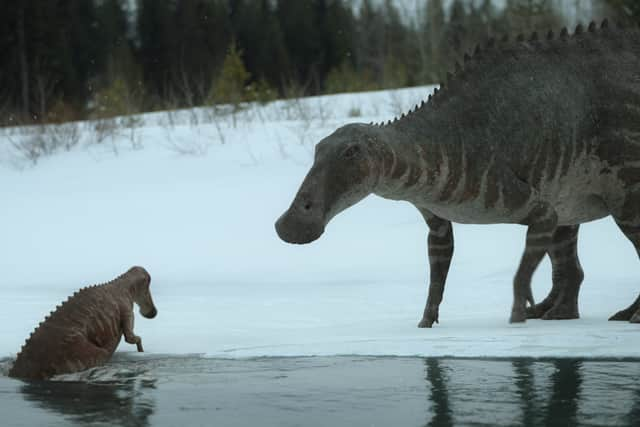Prehistoric Planet review: David Attenborough Apple TV+ series is a remarkable blend of science and spectacle
and live on Freeview channel 276
Perhaps the biggest compliment that can be paid towards Prehistoric Planet is to say that there are moments when you’ll forget that dinosaurs are extinct.
The new Apple TV+ documentary closely resembles others narrated by David Attenborough in style and tone: the same careful observational outlook, the same wry humour, the same reverence and respect for its animal subjects. The difference, of course, is that Prehistoric Planet has been created with photorealistic computer-generated imagery, with executive producer Jon Favreau drawing on (and further advancing) techniques developed for his films The Jungle Book and The Lion King, and his Star Wars television series The Mandalorian.
Advertisement
Hide AdAdvertisement
Hide AdVisually, Prehistoric Planet stands as a remarkable achievement, with each scene invented wholecloth but never once feeling that way. A mottled claw taps a hollow branch, an insect scuttles across sun-scorched earth, waves wash over a footprint left in the sand: true though it is that viewers won’t have seen anything like it before, there’s such a relaxed confidence to Prehistoric Planet that means it’s often easy to lose sight of that fact. It’s ‘filmed’ in such an immersive and tactile way, and the Cretaceous period is rendered with such intricacy and substance, that it’s only when you really stop and dwell on it that you remember none of this is actually happening.
Prehistoric Planet is divided into five episodes, each focused on a different habitat and its occupants: coastal areas, deserts, freshwater environments, ice worlds, and forests. There’s a loose narrative structure within that, but it’s more accurate to describe the documentary as a series of vignettes – a baby Alcione’s first flight, a struggle for dominance between an older and a younger dinosaur, how a rare rainstorm influences the herd. Within that, Prehistoric Planet finds ways to be surprisingly emotionally resonant. There’s something strangely heartbreaking about one dinosaur’s long, slow blink after its child is eaten by a predator – and there’s something quite heartening about that Alcione’s safe landing after its tentative first steps.


Much as the visuals reflect advances in computer technology, so too does the science, not just accommodating for but centring recently developed theories and new breakthroughs in palaeontology. Of the 95 different dinosaurs brought to life for the series, some (such as the Qianzhousaurus or the Corythoraptor) were only discovered in the past decade – but perhaps the most immediately noticeable even to a non-palaeontologist is the inclusion of dinosaurs with feathers, given they’re often missing from pop culture. One memorable early scene sees a young T-Rex swim from one island to another then shake droplets of water off its feathers, at once an understated technical achievement and a quiet challenge to how the animal is typically understood.
Indeed, the dinosaurs are always animals here, never monsters; there’s a real sense of awe and majesty to the series, which genuinely and fully commits to an exploration of their behaviours first and foremost. ‘Deserts’ features a herd of dinosaurs that could understand celestial navigation, and move from one area to another by following the stars, while ‘Coasts’ shows an adult dinosaur teach a juvenile to eat rocks to help with digestion. Prehistoric Planet is a series that understands how and why dinosaurs capture the imagination – but it also knows that pop culture has so far only scratched the surface of how cool they really are.
Advertisement
Hide AdAdvertisement
Hide AdIt’s likely that Prehistoric Planet will leave viewers with more questions than answers, albeit in a good way. (How do we know the dinosaurs could follow the stars? Would one Pterosaur eat another Pterosaur? Palaeontologists, please write in, these aren’t rhetorical questions.) The series isn’t, and doesn’t aim to be, the final word on dinosaurs, instead serving as both introduction and invitation to new palaeontology enthusiasts. Admittedly, it perhaps adheres a little too closely to the style developed by previous Attenborough documentaries, and might’ve benefited from more of an informational guardrail at times – an occasional caption or label, unnecessary for lions in the Sahara or penguins in the Arctic, would’ve provided useful context more than once here.
Nonetheless, though, it’s clear the series is nothing short of a triumph. In an ideal world, Prehistoric Planet will be the first of many such documentaries – but even if there isn’t a Prehistoric Planet II, it’s clear that someone somewhere watching this will be inspired to make 2037’s best dinosaur documentary. That’s its own triumph, too.
Prehistoric Planet begins on Apple TV+ on Monday 23 May, with a new episode released each day through to Friday 27 May. I’ve seen the first two episodes, ‘Coasts’ and ‘Deserts’, before writing this review.
Comment Guidelines
National World encourages reader discussion on our stories. User feedback, insights and back-and-forth exchanges add a rich layer of context to reporting. Please review our Community Guidelines before commenting.
